What’s wrong with this picture?

Cork bark black pine
The tree is growing, but there is no sign of fertilizer.
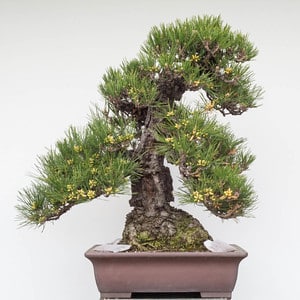
With tea bags filled with cottonseed meal
That’s better. The sooner I can start fertilizing, the stronger I can make the tree by decandling time.
I enjoy seeing the male flowers on pine, despite the mess. Here is the tree from the back and sides.
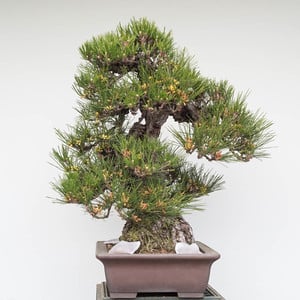
Left side
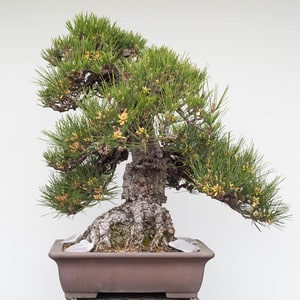
Back

Right side
I usually start with 1-2 units of fertilizer for small sized trees and 3-4 units for larger trees. I treat young and middle-aged trees the same.
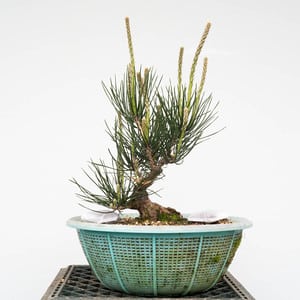
11 year-old black pine

21 year-old black pine
While it’s more common to hold off on fertilizing deciduous varieties to avoid long internodes and large leaves, I make some exceptions.
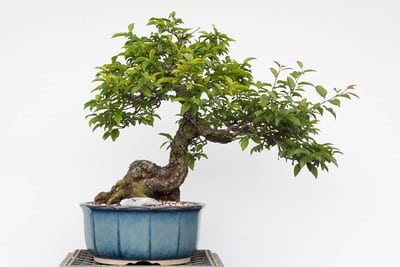
Japanese plum
My plum is the first tree to show signs of growth each year, and if I don’t start feeding quickly, the leaves turn yellow.
Why mention fertilizer so early in the season? Because the sooner fertilizing begins, the more vigor can be produced in a given year. While this can be important for all varieties, it’s especially important for pines that are to be decandled as there’s only so much time between repotting and decandling.
I usually wait three weeks after repotting to begin fertilizing. My standard fertilizers are fish emulsion and cottonseed meal, but this year I’m planning to use a greater variety of fertilizers to ensure the trees get a broader variety of nutrients.
Is it time to start fertilizing in your garden?
Subscribe to Bonsai Tonight
New Posts Delivered Every Tuesday and Friday
Nico says
Hi Jonas,
First of all, thank you for your blog, I really enjoy reading every single post!
I was wondering, do you remove the male flowers on pines? Do they have an impact on how you decandle the tree later on?
Many thanks!
Nico
Jonas Dupuich says
Thanks Nico! I typically don’t remove the male flowers as they tend to dry up and fall away on their own. As far as I know, they don’t have a big effect on growth or decandling.
Male flowers are often a sign of stress, but not always. This cork bark often blooms like this after decandling – itself a pretty stressful technique.
Gary R Croft says
Jonas,
What is this cottonseed meal? Have never come across it here in Australia but then again it could be called something else I’m not aware of.
Am currently in Japan and hoping to go to Shunka-En bonsai that Master Kimura runs near the Sumida River in Tokyo by the later part of this month. At Omiya Bonsai Museum they also had the teabags around their pines-6 to 8 depending on the size of the tree and not having a translator with me,I couldn’t ask what they were using.
Could have been the very same cottonseed meal for all I knew.
It will all be revealed in time maybe. Gary Croft
Jonas Dupuich says
Hi Gary, Cottonseed meal is ground up seeds from cotton plants. After ginning and extracting the oil, what remains is ground up and used for fertilizer or feed. In Japan rapeseed meal is more common (in the US we essentially replace rapeseed meal with cottonseed meal). Both are good organic fertilizers that when mixed with other ingredients can make good fertilizer balls or dango.
Sounds like you’re having a great time in Japan – am happy to hear it!
Bruce Winter says
Fish emulsion now comes in pellets, a convenient addition to liquid.
averilstanley says
Gary, we purchase our Cottonseed and Soy bean fertiliser from Farm produce suppliers – in bulk – check the yellow pages for suppliers in your area
Gary R Croft says
Jonas thanks for reply-
It is rapeseed oil production that is in swing in the state of Victoria/Aust and available-the name rapeseeed has been changed for political correctness over the years. So now I know I know what I’m after.
Yes Japan’s awesome for bonsai if you can be guided to look by others-so much secret.
The park beside Hemeiji Castle has wonderful flowering varieties with the distressed trunk/bark etc,that can be photographed up lose and personal without intervention.
Some of the bonsais give the appearance of venerable age (and a little lime sulphur solution would help on the flowering apricot I noticed).
There is very striking weeping cherry that was coming into its own for the Sakura viewing time-good pot good balance.
Showa-Koen Memorial Park has outside display of 50+trees openly available to photograph when in Tokyo for those restricted by the regime at Omiya Bonsai Museum.
theyoushow2000 says
Nice tree!
Stefan says
Thanks for the blog post. I have been using teabags filled with fertliizer myself since last year. One of the effects I noticed with my trees is mold beneath the teabags. Could you elaborate on this (negative aspect?, how to counteract this?)?
Jonas Dupuich says
Hi Stefan, good question – I think the answer depends on what kind of growth it is. Some fungal growths are beneficial, others aren’t. I typically don’t try to avoid growth like this unless it becomes clear that it’s harmful. It may also be that there’s too much moisture around.